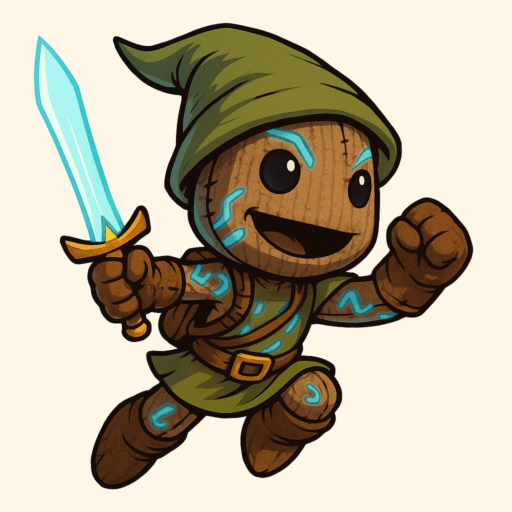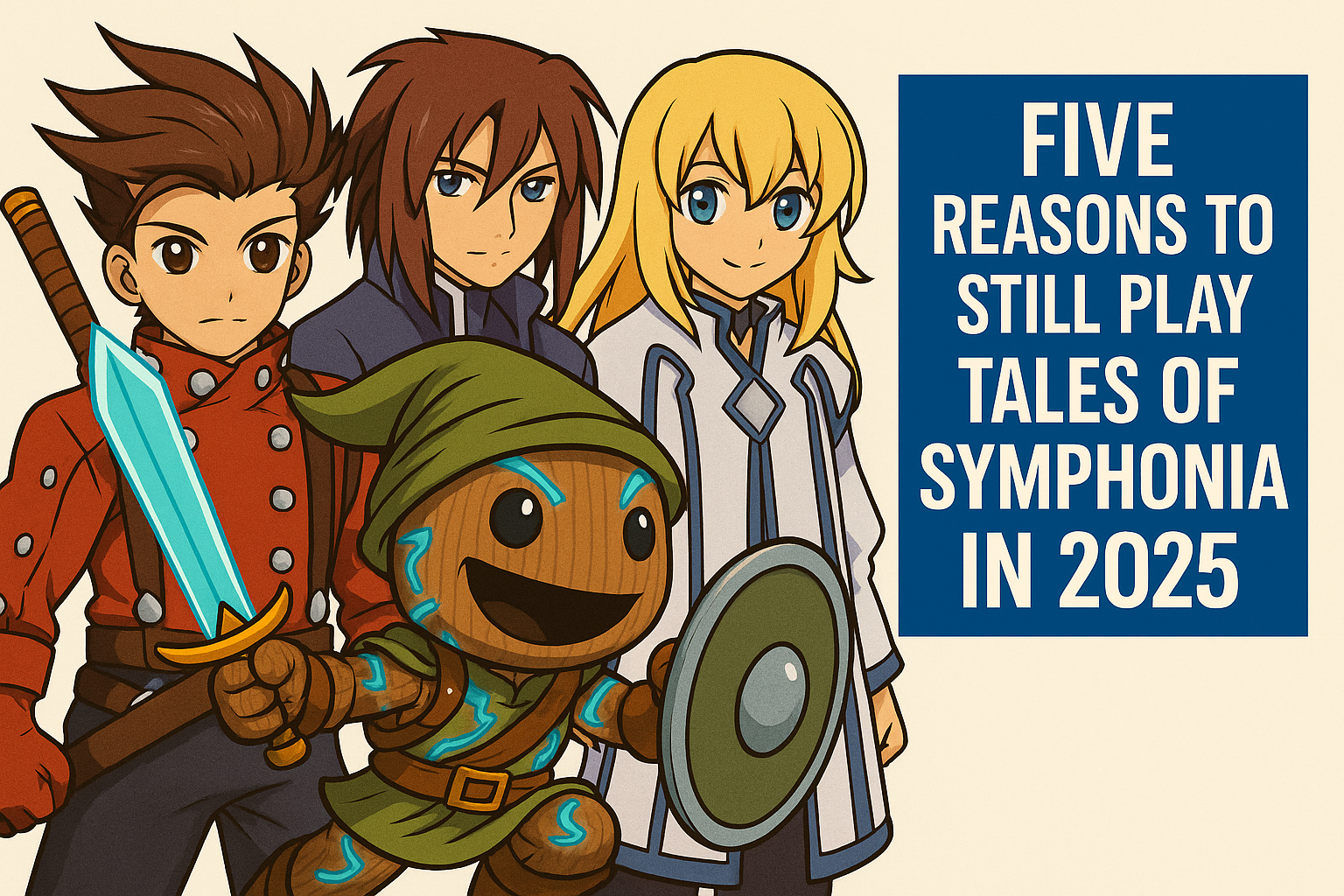As the Tales franchise celebrates its 30th anniversary in 2025, few titles represent its legacy better than Tales of Symphonia. It’s also one of my favorite games EVER! I wasn’t familiar with the Tales of series prior to this game, but once I discovered Tales of Symphonia, I never left!
First released in 2003, the game quickly became a fan-favorite and a gateway for Western audiences into the Tales universe. Whether you played it back in the day or are discovering it for the first time, there are plenty of reasons to revisit this classic JRPG. Here are our top five.
1. Celebrating 30 Years of the Tales Series
Three decades of Tales means three decades of iconic characters, unique gameplay systems, and unforgettable storytelling. Tales of Symphonia was a breakthrough for the franchise. It was the first 3D entry and the first to gain serious traction outside of Japan. The game helped define the tone and style for future titles. It was also a technological step forward for JRPGs, with voice acting, animated cutscenes, and real-time combat that was still rare at the time.
Playing Symphonia now isn’t just revisiting a classic; it’s participating in the legacy of one of gaming’s longest-standing series. Expect online community events, anniversary merchandise, and possible crossover content across Tales titles during the 30th-year celebration.
2. An Epic Story of Dual Worlds and Sacrifice
The narrative of Tales of Symphonia weaves a complex tale between two co-existing worlds: Sylvarant and Tethe’alla. The game’s early premise seems simple—a chosen one must save the world—but quickly evolves into a rich exploration of moral ambiguity, identity, and what it means to truly save someone.
Characters you trust may betray you, and villains often believe they’re acting for the greater good. The game challenges players to reflect on themes of systemic injustice, environmental depletion, and the price of peace. Lloyd Irving, the main protagonist, isn’t your typical hero. He’s a flawed, impulsive idealist who learns and grows alongside the player. It’s a story that still holds emotional weight today.
3. Memorable Characters and Meaningful Choices
Each member of the Symphonia party has depth, conflict, and an arc that evolves over the journey. Colette, the soft-spoken Chosen, hides an inner turmoil that reshapes your understanding of sacrifice. Kratos, a mysterious swordsman, may be one of the most complex characters in the Tales series, with a personal connection to the story’s core mystery.
Players influence character bonds through dialogue choices and side quests. These interactions affect gameplay, such as who joins you in optional scenes or how certain battles unfold. There’s even a pseudo-romance system that can change key scenes depending on who Lloyd grows closest to. It’s an RPG where your choices matter in small but impactful ways.
One of the game’s greatest strengths lies in its characters. Each has a backstory, unique combat abilities, and emotional depth. Here’s a breakdown:
| Character | Weapon | Role | Personality |
|---|---|---|---|
| Lloyd Irving | Twin swords | Frontline fighter | Honest, determined, sometimes rash |
| Colette Brunel | Chakrams | Healer/support | Selfless, quiet, carries emotional weight |
| Genis Sage | Kendama | Mage | Intelligent, sarcastic, protective |
| Raine Sage | Staff | Healer/Support Mage | Logical, mysterious, teacher figure |
| Kratos Aurion | Sword | Balanced attacker | Calm, complex backstory |
| Zelos Wilder | Sword | Hybrid fighter/support | Flirty, secretly thoughtful |
| Presea Combatir | Axe | Heavy damage dealer | Quiet, tragic past |
| Regal Bryant | Bare fists | Power-focused fighter | Noble, reserved |
These characters evolve based on player choices, leading to different outcomes and relationship dynamics. That adds replay value and emotional weight to every decision.

4. Engaging Combat and Progression Systems
At its core, Tales of Symphonia features the Linear Motion Battle System, which allows real-time combat on a 2D plane within 3D environments. Unlike traditional turn-based JRPGs, you control one character directly while others are managed by AI or friends via couch co-op. Each character has a distinct playstyle, from Genis’ long-range magic to Regal’s martial arts.
The combat becomes deeper with Unison Attacks—a feature that lets you combine abilities with your team for powerful group combos. Leveling up unlocks new artes and passive skills, and tech trees let you customize characters to fit your battle strategies. Despite its age, the system still feels fast, responsive, and more tactical than many newer JRPGs.
5. Rich Endgame Content and Replayability
Symphonia doesn’t stop after the credits roll. The game encourages replaying with the Grade Shop, where you use points earned during your first run to carry over skills, items, or enhancements into New Game Plus. This lets you experiment with different builds and unlock all of the title-based character achievements.
Optional bosses like the Sword Dancer or the Abyss challenge your understanding of the battle system. The Coliseum offers combat-focused content with unique rewards. Plus, there are alternate skits, scenes, and endings based on your playstyle and relationship choices. There’s easily over 100 hours of content if you’re looking to see and do everything.
Tales of Symphonia: The Animation
Not ready to jump into the game? Or maybe you’re looking to re-experience the story differently? Tales of Symphonia: The Animation adapts the full plot across three arcs: Sylvarant, Tethe’alla, and United World. Produced by Ufotable, known for their high-quality visuals, the series condenses the game’s main events while highlighting key emotional beats.
It’s a solid companion piece to the game and a great entry point for newcomers who want to grasp the story without investing dozens of hours upfront.
I also made an AMV using scenes from the anime, hope you like it:
Where to Play Tales of Symphonia in 2025
- GameCube (Original): The original version, still beloved for its stable frame rate.
- I literally have over 200 hours in this version of the game;
- PlayStation 2 (Japan Only): Slightly downgraded visuals, but with extra content.
- PlayStation 3: Bundled with Tales of Symphonia: Dawn of the New World in Chronicles.
- PC (Steam): A reliable port with controller support and minor graphical upgrades.
- Nintendo Switch, PS4, Xbox One: The 2023 remastered version brought it to current-gen consoles. Best performance is on PS4/PS5 or Xbox Series X|S. The Switch version had some issues with frame pacing and load times but remains playable.
Top 5 Most Asked Questions About Tales of Symphonia
Q1: Is the game beginner-friendly for new JRPG fans?
Yes. While it offers depth for veterans, Symphonia eases players in with tutorials, a slow ramp-up in difficulty, and accessible combat. The optional skits help with understanding the story and party dynamics.
Q2: Is multiplayer still possible?
Yes, couch co-op is available during battles. Up to four players can control party members in fights, which adds a lot of fun during tougher boss encounters.
Q3: What’s the deal with the sequel?
Tales of Symphonia: Dawn of the New World continues the story with two new protagonists, Emil and Marta. Some fans appreciate the continuation, while others feel it doesn’t live up to the original’s depth.
Q4: How long is the game?
A casual run takes 50–60 hours. Completionists can easily sink 100+ hours due to side quests, titles, and New Game Plus content.
Q5: What’s the best version to play in 2025?
If performance matters, the PlayStation 3 or Steam versions are your best bet. If you’re on console, PS4/PS5 and Xbox Series X offer smoother experiences than the Switch.
Looking back or playing for the first time, Tales of Symphonia still delivers a compelling mix of heartfelt story, tactical gameplay, and deep character development. And in 2025, there’s never been a better time to return to the world of Sylvarant and Tethe’alla.
Stay tuned to GameLikeADutchie for more RPG retrospectives, guides, and nostalgic deep dives.
Have you ever play Tales of Symphonia? Feel free to leave a reply in the comments.
Enjoyed reading? Also check out our other blog posts. We f.e. made a post about: Five Reasons Why the Launch of Oblivion Remaster Is Great for the Future of Gaming but also 5 Classic PlayStation Franchises That Need a Comeback on PS5 in 2025 and explore Fortnite x Star Wars: Galactic Battle – Everything You Need to Know


Leave a Reply